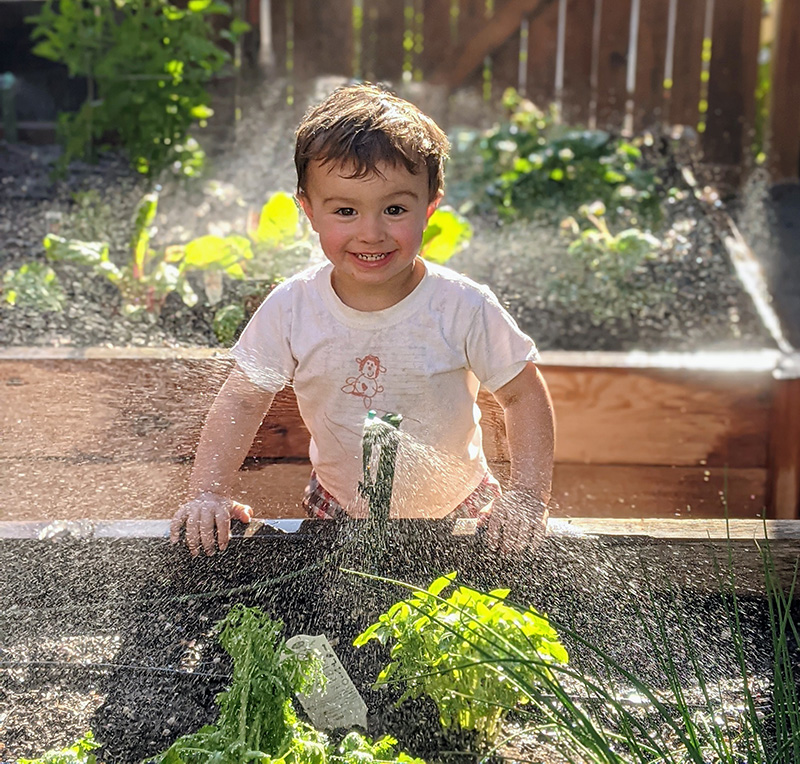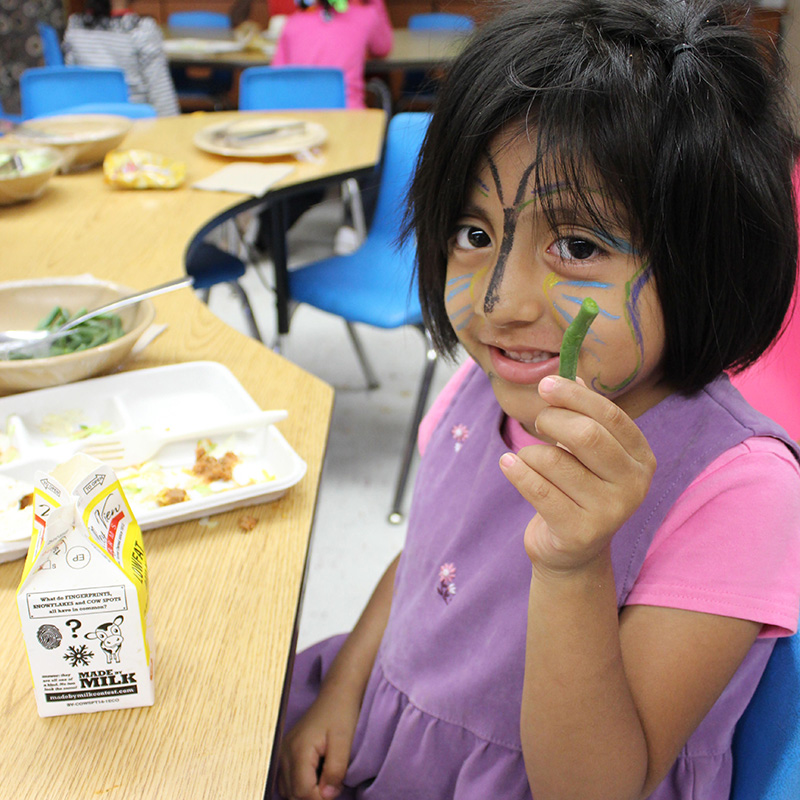As childcare centers, preschools and other early education settings strive to stretch every penny, they often face daunting challenges in providing nutrient-rich food with limited resources. The default for many programs is to head to Costco or other big retailers and buy in bulk, which often means processed, “convenient” food and snacks. According to Kelly Etter, Ph.D., vice president of the Policy Equity Group’s Early Childhood Equity Initiatives, many children in these settings get as much as two-thirds of their daily nutrient needs in childcare settings. That adds up to a lot of processed food, often with an equity component of who gets better, fresher food.

Fortunately, Etter says, there’s a delicious alternative to this situation and it pretty much defines win-win-win: Farm to Early Care and Education.
Farm to Early Care and Education (ECE) programs have been around for more than a decade and can be found in all types of early childhood settings, from preschools and family childcare homes to Head Start/Early Head Start programs and in K-12 school districts. The programs provide nutrient-dense, minimally processed, local foods, and help small children develop food literacy through school gardens, cooking, field trips and a plethora of other activities aimed at helping them understand where their food comes from. Adapting the community-based models found in the National Farm to School Network (NFSN), Farm to ECE programs teach young kids about food and nutrition, and, by working with local farmers and food producers, boost the local farm economy, build community and help improve public health outcomes. By investing in local producers who are women, Black, Indigenous and other people of color (BIPOC), Farm to ECE programs provide a powerful pathway to advance racial and social equity.
“Farm to ECE is such a natural fit for kids in this age group,” Etter says. “The approach is all about hands-on exploration and learning, and kids love that. They love cooking. They love dressing up as farmers or bakers and acting out stories like The Little Red Hen. They love exploring dirt and learning about animals.

“The focus of Farm to ECE is promoting access to local, nutrient-dense foods for children in childcare settings, with a specific eye toward connecting woman-owned farmer or BIPOC-owned farms or producers. The other piece is educating them about where their food comes from,” she says. “Even if a program doesn’t have the space or resources to have a big, outdoor garden, this model can help them do smaller-scale container gardens and let the children watch the magical process of plants growing.”
The idea of Farm to ECE has developed over the past decade from a few scattered providers growing gardens at their preschools, to a movement with thriving programs across the country. Some states now integrate Farm to ECE into their statewide early childhood plans. The aim of these programs is to develop the next generation of responsible food consumers and to support sustainable, equitable and just local food systems. Though the benefits of these programs seem intuitive (little kids, local food, community involvement: What’s not to love?), until now, the actual impacts had not been quantified or evaluated extensively.
It’s one thing to believe that a program is wonderful, but funders and policymakers often want more quantitative evidence. Good metrics drive good strategy.
For the past six years, the Policy Equity Group, a national consultancy devoted to the well-being of children, has provided technical assistance to nine states that are implementing Farm to ECE programs, supported by a grant from the W.K. Kellogg Foundation. Late this summer, the group, in partnership with the National Farm to School Network (NFSN), released the Farm to Early Care and Education Shared Metrics, a powerful resource for families, providers, funders, policymakers and others interested in seeing this sensible model take root in local communities. The resource was two years in the making, headed by former NFSN Program Director Lacy Stephens and Dr. Etter, with a team of 13 contributors.

“As Farm to ECE is still growing as a movement and the evidence base is still developing, NFSN and the Policy Equity Group saw a need to identify and refine priority areas both in research and programing,” says Sophia Riemer, Farm to ECE associate at NFSN and one of the project’s contributors. “We developed the resource as a toolkit to help guide and advance the movement and to spotlight priorities, such as a focus on equity, and to identify gaps within existing research and strategy.”
The outcomes and indicators that underpin the toolkit were stakeholder-driven from the beginning, says Dr. Etter, based on conversations with those in the Farm to ECE trenches.
“Three years ago, at our last in-person convening before the pandemic, we had all our partners together in a room and we did a Mad Libs-like activity,” Etter says. “We asked them to complete the sentence: When we implement Farm to ECE programs, we expect that [who?] will experience [what changes?]. We asked them to fill in the blanks, and they put up hundreds of sticky notes showing who they thought their work benefits and in what ways. All those sticky notes became the birth of this framework.
“We wanted to give them a tool where they could say, ‘I think this work is helping shape children’s food preferences at an early age and is increasing market opportunities for local food purveyors,’ and then find the tools and measures they need to prove it.”
To this end, the authors of the shared metrics resource, set about identifying existing metrics—such as surveys for families or childcare providers, classroom observation tools, etc.—and compiled them into one easy-to-use toolkit.
The Farm to ECE Shared Metrics resource is organized according to outcomes for the intended beneficiaries of the program:
- Children
- Families
- ECE providers
- Farmers and food producers
- Communities/systems
The document then organizes each of these areas into priority outcomes—the desired “ends”—and the evidence-based indicators and measures that show whether those outcomes have been achieved.

The authors say the toolkit is useful to all stakeholders in the ECE landscape: program administrators and partner organizations seeking to design, implement and expand Farm to ECE programs; researchers and program evaluators wanting to shape their research; evaluators building evidence for funding and suggesting ways programs can refine their offerings; grant program administrators and funders to align funding priorities and reporting requirements. The resource is truly a one-stop shop for taking the guesswork out of how to thoughtfully evaluate whether and how Farm to ECE programs are working so programs are set up to succeed.
For those who want to start a Farm to ECE program from scratch, NFSN has created a library of “getting started” guides that provide a roadmap of best practices and lessons learned—including The Creative Curriculum for Infants, Toddlers & Twos. Farm to ECE with babies! The shared metrics’ accompanying “User Guide and Framing Resource” also can serve as an instruction manual for potential users.
Farm to Early Care and Education sounds good, but to overworked, over-extended teachers, it can show up like just one more thing on an already overflowing To-Do list. “Our partners were telling us that teachers were often like, ‘I have a thousand things to do already and what? You want me to do this Farm to ECE thing? I don’t know …’” says Dr. Kelly Etter of the Policy Equity Group. [Read more]
The resource is not intended to be used in its entirety by any stakeholder or community, but to serve as a menu of options depending on the program, policy goals or community interests. Etter stresses that the resource is intended to be a “living document” that will continue to be updated with new information and new resources as the work of evaluating Farm to ECE continues to evolve. It is both inspirational and aspirational, she says, and the hope is that gaps identified in evaluating the programs will help drive development of new approaches to assessing the movement’s impact and outcomes.
Because Farm to ECE comprises many different stakeholders, from children and families to childcare providers and local farmers, foundations, and funders to policymakers, codifying its many values is a complicated project. Giving form and substance to those values through this well-thought-out shared metrics toolkit represents a giant step toward developing a vibrant, equitable, community-based food system that begins with the nation’s youngest children and their families.
“Working toward shared priorities and language can help unify the Farm to ECE field toward common goals, which can help us build the argument for continued and greater funding and support,” Riemer says. “Ultimately, this will lead to higher quality, more equitable, and more expansive Farm to ECE programming throughout the country.”
RESOURCES
- Equitable Food Systems Resource Guide—Our current food system is deeply inequitable, threatening the health and economic vitality of communities throughout the U.S. This resource guide from PolicyLink provides all stakeholders, from consumers to policymakers, with comprehensive, actionable framework to understand what an equitable food system can look like and to see the opportunities across all sectors in advancing equity and policy change.
- Policy Equity Group—Washington, D.C.-based organization that focuses on building the capacity of socially conscious organizations dedicated to creating stronger early childhood systems that improve developmental, educational, health, and nutritional outcomes for vulnerable children throughout the U.S.
- National Farm to School Network—The National Farm to School Network started in the late 1990s as an information, advocacy and networking hub for communities working to bring food and agriculture education into school systems and to source food locally. It is now found in 46 states, reaching more 24 million students, and generating $789 million for local food providers.
- Farm to ECE Shared Metrics Resource—Free to download and share.
- Farm to ECE Curricula—Provides a list of all the farm to early care and education curricula available through the National Farm to School Network, from preschool lesson plans to garden-themed education kits for childcare center staff. A boon to overwhelmed educators everywhere.

K.C. Compton
K.C. Compton worked as a reporter, editor and columnist for newspapers throughout the Rocky Mountain region for 20 years before moving to the Kansas City area as an editor for Mother Earth News. She has been in Seattle since 2016, enjoying life as a freelance and contract writer and editor.



